ElectricElectric ForcePolarizationInsulatorElectric Field of Charged RodElectric Field of Charged Ring, Disk, and PlaneElectric Field of Charged Spherical ShellPotential EnergyPotential DifferenceElectric PotentialElectric EnergyElectric CurrentMagnetic FieldKirchhoff's Current LawSteady StateCapacitor Charge and DischargeRC Circuit Time ConstantCurrent Density, ConductivityMagnetic ForceElectricity, MagnetismMotor, GeneratorGauss's LawAmpere's LawFaraday's Law, Lenz's LawSuperconductor, InductorMaxwell's EquationsWave Equation
Draft for Information Only
Content
Capacitor
Capacitor Charging
Capacitor Discharging
Capacitance
Fringe Field of Edge
Source and Reference
Capacitor
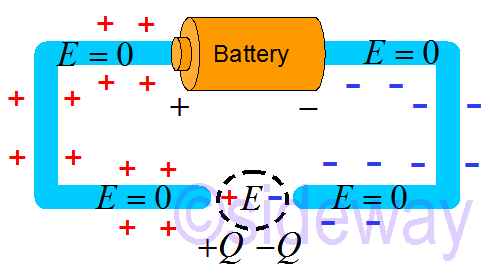 Before a circuit is connected: No current flows through the wire conductors. In equilibrium state, charges from battery move to the ends of wire conductors to prevent current from flowing.
Before a circuit is connected: No current flows through the wire conductors. In equilibrium state, charges from battery move to the ends of wire conductors to prevent current from flowing.
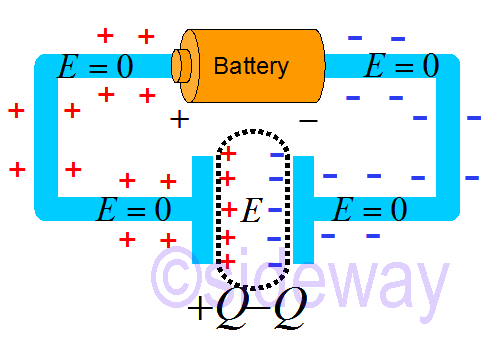 When plates are added to the ends of wire conductors, more charges move to the end plates of the wire conductors in order to prevent current from flowing. The two plates structure with large parallel surface area is called a capacitor. And the circuit symbol is
When plates are added to the ends of wire conductors, more charges move to the end plates of the wire conductors in order to prevent current from flowing. The two plates structure with large parallel surface area is called a capacitor. And the circuit symbol is

Capacitor Charging
When a empty capacitor is connected in series with a battery and a light bulb.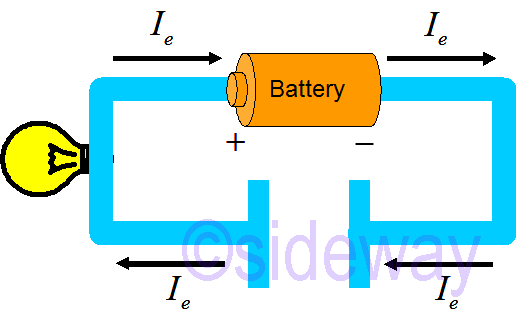 At the initial state, electron current flows into and out of capacitor respectively, but not through the capacitor after the two wire connectors are connected to the battery. Since electron current flows through the electric bulb more freely, the electric bulb is lighted to maximum initial brightness.
At the initial state, electron current flows into and out of capacitor respectively, but not through the capacitor after the two wire connectors are connected to the battery. Since electron current flows through the electric bulb more freely, the electric bulb is lighted to maximum initial brightness.
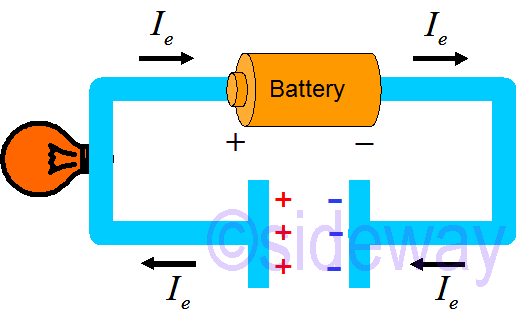 At the transition state, charges start to build up on capacitor. Less electron current flows through the electric bulb, the electric bulb is lighted to medium brightness.
At the transition state, charges start to build up on capacitor. Less electron current flows through the electric bulb, the electric bulb is lighted to medium brightness.
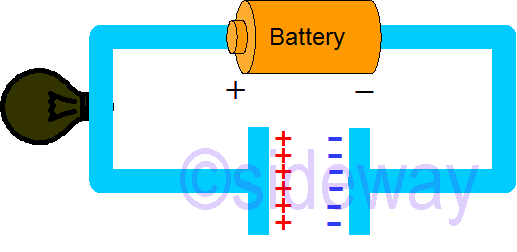 At the final state, charges built up on capacitor stops electron current from flowing finally. Fringe field of the capacitor rises until the electric field in the wire equals to zero, i.e. in equilibrium stat. No electron current flows through the electric bulb, the electric bulb is not glowing.
At the final state, charges built up on capacitor stops electron current from flowing finally. Fringe field of the capacitor rises until the electric field in the wire equals to zero, i.e. in equilibrium stat. No electron current flows through the electric bulb, the electric bulb is not glowing.
Capacitor Discharging
When a fully charged capacitor is connected in series with a light bulb.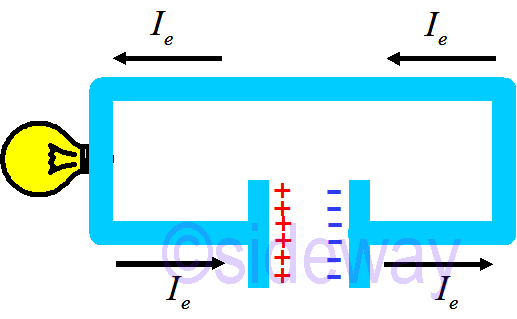 At the initial state, electron current flows iout of and into capacitor respectively, but not through the capacitor after the two wire connectors are connected to the light bulb. Since electron current flows through the electric bulb more freely, the electric bulb is lighted to maximum initial brightness.
At the initial state, electron current flows iout of and into capacitor respectively, but not through the capacitor after the two wire connectors are connected to the light bulb. Since electron current flows through the electric bulb more freely, the electric bulb is lighted to maximum initial brightness.
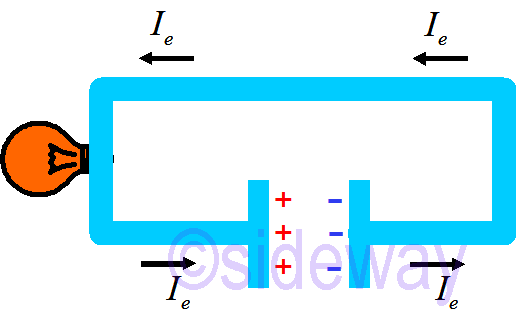 At the transition state, charges start to discharge from capacitor. Less electron current flows through the electric bulb, the electric bulb is lighted to medium brightness.
At the transition state, charges start to discharge from capacitor. Less electron current flows through the electric bulb, the electric bulb is lighted to medium brightness.
 At the final state, charges built up on capacitor is exhausted and electron current flowing capacitor stop finally. No electron current flows through the electric bulb, the electric bulb is not glowing.
At the final state, charges built up on capacitor is exhausted and electron current flowing capacitor stop finally. No electron current flows through the electric bulb, the electric bulb is not glowing.Since the charged capacitor is charged under an external electric field, like charges are packed more closely. Therefore, although opposite charges attract, but the like charges are repelling more. Besides the fringe field of plates is not zero.
Capacitance
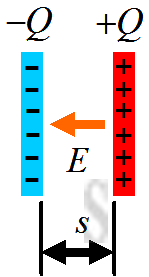 Capacitance is the ability of holding electric charge in the capacitor with respect to the corresponding change in the electric potential being applied on.
Capacitance is the ability of holding electric charge in the capacitor with respect to the corresponding change in the electric potential being applied on.
𝑄=𝐶∆𝑉
Electric field in a capacitor:𝐸=𝑄/𝐴𝜀0, And
∆𝑉=−𝑓∫𝑖
𝐸
∙𝑑𝑙→|∆𝑉|=𝐸𝑠→|∆𝑉|=𝑄/𝐴𝜀0
𝑠→𝑄=𝜀0𝐴𝑠
|∆𝑉|
Therefore, capacitance of a parallel-plate capacitor:
𝐶=𝜀0𝐴𝑠
Fringe Field of Edge
𝐸fringe=𝑄/𝐴𝜀0
(𝑠𝐴
)
Source and Reference
https://www.youtube.com/watch?v=DlXB4XFJtos&list=PLZ6kagz8q0bvxaUKCe2RRvU_h7wtNNxxi&index=16©sideway
ID: 191203102 Last Updated: 12/31/2019 Revision: 0
Latest Updated Links
- Ikea SANDSBERG table(last updated On 11/4/2025)
- Ikea TISKEN toilet roll holder(last updated On 11/3/2025)
- Philips CL400 Ceiling Light 36W(last updated On 11/2/2025)
- Philips CL400 Ceiling Light 24W(last updated On 11/1/2025)
- Philips CL400 Ceiling Light 13W(last updated On 10/30/2025)
- Ikea TISKEN basket(last updated On 10/29/2025)
- Ikea TISKEN towel rack(last updated On 10/28/2025)
- Ikea REXBEGONIA mattress protector(last updated On 10/27/2025)
- Ikea KEJSAROLVON mattress protector(last updated On 10/26/2025)
- Ikea KVARNVEN ergonomic pillow(last updated On 10/25/2025)
- Ikea BRUKSVARA pocket prung mattress(last updated On 10/24/2025)

 Nu Html Checker
Nu Html Checker  53
53  na
na  na
na
Home 5
Business
Management
HBR 3
Information
Recreation
Hobbies 8
Culture
Chinese 1097
English 339
Travel 18
Reference 79
Hardware 27![]()
Computer
Hardware 259
Software
Application 213
Digitization 37
Latex 52
Manim 205
KB 1
Numeric 19
Programming
Web 289
Unicode 504
HTML 66
CSS 65
SVG 46
ASP.NET 270
OS 431
DeskTop 7
Python 72
Knowledge
Mathematics
Formulas 8
Set 1
Logic 1
Algebra 84
Number Theory 206
Trigonometry 31
Geometry 34
Calculus 67
Engineering
Tables 8
Mechanical
Rigid Bodies
Statics 92
Dynamics 37
Fluid 5
Control
Acoustics 19
Natural Sciences
Matter 1
Electric 27
Biology 1
